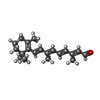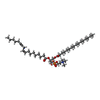+Search query
-Structure paper
| Title | Structural basis for ion selectivity in potassium-selective channelrhodopsins. |
|---|---|
| Journal, issue, pages | Cell, Vol. 186, Issue 20, Page 4325-4344.e26, Year 2023 |
| Publish date | Sep 28, 2023 |
 Authors Authors | Seiya Tajima / Yoon Seok Kim / Masahiro Fukuda / YoungJu Jo / Peter Y Wang / Joseph M Paggi / Masatoshi Inoue / Eamon F X Byrne / Koichiro E Kishi / Seiwa Nakamura / Charu Ramakrishnan / Shunki Takaramoto / Takashi Nagata / Masae Konno / Masahiro Sugiura / Kota Katayama / Toshiki E Matsui / Keitaro Yamashita / Suhyang Kim / Hisako Ikeda / Jaeah Kim / Hideki Kandori / Ron O Dror / Keiichi Inoue / Karl Deisseroth / Hideaki E Kato /    |
| PubMed Abstract | KCR channelrhodopsins (K-selective light-gated ion channels) have received attention as potential inhibitory optogenetic tools but more broadly pose a fundamental mystery regarding how their K ...KCR channelrhodopsins (K-selective light-gated ion channels) have received attention as potential inhibitory optogenetic tools but more broadly pose a fundamental mystery regarding how their K selectivity is achieved. Here, we present 2.5-2.7 Å cryo-electron microscopy structures of HcKCR1 and HcKCR2 and of a structure-guided mutant with enhanced K selectivity. Structural, electrophysiological, computational, spectroscopic, and biochemical analyses reveal a distinctive mechanism for K selectivity; rather than forming the symmetrical filter of canonical K channels achieving both selectivity and dehydration, instead, three extracellular-vestibule residues within each monomer form a flexible asymmetric selectivity gate, while a distinct dehydration pathway extends intracellularly. Structural comparisons reveal a retinal-binding pocket that induces retinal rotation (accounting for HcKCR1/HcKCR2 spectral differences), and design of corresponding KCR variants with increased K selectivity (KALI-1/KALI-2) provides key advantages for optogenetic inhibition in vitro and in vivo. Thus, discovery of a mechanism for ion-channel K selectivity also provides a framework for next-generation optogenetics. |
 External links External links |  Cell / Cell /  PubMed:37652010 / PubMed:37652010 /  PubMed Central PubMed Central |
| Methods | EM (single particle) |
| Resolution | 2.53 - 2.66 Å |
| Structure data | EMDB-34530: Membrane protein A EMDB-34531: Membrane protein B EMDB-35713, PDB-8iu0: |
| Chemicals |  ChemComp-RET:  ChemComp-PSC:  ChemComp-PLM:  ChemComp-HOH: |
| Source |
|
 Keywords Keywords |  MEMBRANE PROTEIN / MEMBRANE PROTEIN /  Cryo-EM Cryo-EM |
 Movie
Movie Controller
Controller Structure viewers
Structure viewers About Yorodumi Papers
About Yorodumi Papers









 hyphochytrium catenoides (eukaryote)
hyphochytrium catenoides (eukaryote)